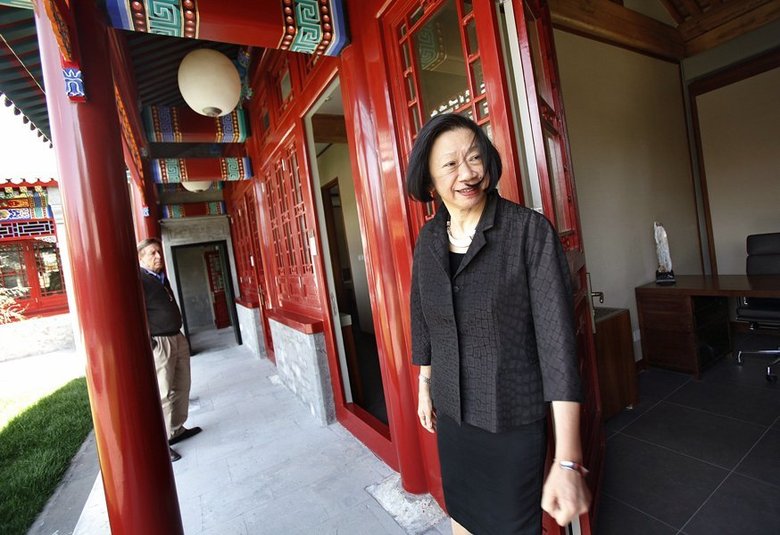With an exterior appearance well-blended with the local atmosphere, including hand-painted scenery and humble traditional Chinese architecture, it is difficult to imagine the expansiveness and elaborateness of the Stanford Center’s underground depths, which boast three levels of state-of-the-art facilities. Yet the same probably goes to the awe-striking woman who runs the place, Professor Jean C. Oi. For it took me, with an incredible chance of luck, to actually take part in one of her courses before I was able to have a grasp of the charismatic individual that she is.

Professor Jean C. Oi is the William Haas Professor in Chinese Politics, in the Department of Political Science at Stanford University, but she is also senior fellow of the Institute for International Studies, where she directs the China Program. Leading Stanford’s China Initiative, Professor Oi helped establish Stanford’s Center at Peking University (SCPKU) in the year 2012, and she remains the founding director up to this day.
Yet Professor Oi’s involvement with Peking University far predates the construction of the Stanford Center infrastructure itself. In fact, back in 2002, Professor Oi had spent two weeks on campus teaching China’s political situation to students from the United States, who were part of an Overseas Seminar Program. "Everyone realizes China will be a major player—economically, politically, in all the realms," explains Professor Oi, and the campus of Peking University is literally at the heart of the Chinese academic sphere. She adds that, Stanford graduates, from engineers to humanities majors, will increasingly need to interact with Chinese businesses and colleagues in China. "So they need to have hands-on understanding of what China is—the kind of training you can't get from reading a book," Professor Oi said. Perhaps that is an apt summary of not only the mission of the center, but also Professor Oi’s duo role as director and instructor.
Speaking of Professor Oi at the seminar table, I was incredibly lucky to have her as a substitute teacher for the first two sessions of Chinese Society in the Post-Mao Era, a course exploring major social trends in Post-Mao China, hosted weekly at the Stanford Center.
What distinguishes Professor Oi as an instructor, besides her incredible subject proficiency, of course, is how she constantly draws upon personal anecdotes helping students to better contextualize issues. For example, amidst a discussion over village elections, Professor Oi proudly recalls her rural surveying experiences, where she was lucky to witness firsthand an attempt to implement secret ballots in a local school house. She recreates for us the scene where seven villagers are allowed into a classroom with seven individual voting tables in place, “But guess what happens?” she asks the class. “Rather than filling ballots individually, the villagers gather around one table to deliberate!” As we break out laughing, we better appreciate the notion of electoral democracy as a gradual learning process.
Professor Oi also stands out in her assertiveness and her unveiled candidness. Whenever a great idea is thrown out, you can count on her unreserved approval, but whenever something questionable is voiced over the discussion table, she will not hesitate to point out its insufficiency, unlike your typical instructor who might hint elusively. If you respond to Professor Oi with a problematic answer, expect to face a pummeling, interrogating exchange, “Really? I don’t think so. Explain to me how that would be the case?” Yet at the same time, Professor Oi applies these standards to herself as well. She makes sure to avoid logical leaps in explanations and to always take the time to raise questions regarding her own lecture, “But is vote-buying really bad?” “Are protests really bad?” Perhaps it is part of her identity as director that gives Professor Oi an assertive and probing edge in her teaching styles. This challenges students to be critical, meticulous, and constantly on their toes.
What’s more, there are other perks of being in charge of the place. For a class packed in an undersized room, it only took one simple phone call from Professor Oi to instantly relocate the entire class to a spacious lecture hall, one floor above. Besides the obvious convenience, it also allows Professor Oi maneuvering space to tailor her courses. For example, to spice things up, Professor Oi provided a pizza lunch while the class enjoyed a lively discussion that went way past the period and extended well into noon. Indeed, there come certain privileges that amount to even greater appreciation of being able to work with Professor Oi, and being constantly challenged academically.
Professor Oi has been director of the Stanford Center for three years and counting, and under her effort the center has become a venue for mutual learning and understanding for both Stanford University and Peking University students alike. For California natives, "it's difficult to convey the different world [the Chinese] are living in," without actually being in the heart of things. Whereas for Chinese students, the center nestled in the serene and scenic northern end of campus is an independent ecosystem in the middle of a bustling intellectual hub, where one can take the first step towards the outside world.
Written by: Andrew Mao
Source: PKU Newsletter (Autumn 2015)



